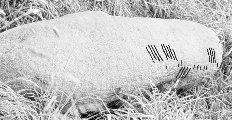Location and history:
For the location and discovery, cd. {155}.
Size according to Brash, OIM 203: 4'3" x 1'3" x 11"
Size according to Macalister, CIIC: 3'6" x 1'4" x 0'8"
Published illustrations:
- Macalister, CIIC I, 153 (
 draft).
draft).
Reading Ferguson PRIA 15, 1871, 62:
"S(outh) Side":
MAQIDECCOD[A]
"N(orth) Side":
CAQOSICECCUDO[ROS?]
"Proposed Verbation":
maqi deccod[a]. caqosi ceccudo[ros?]
The stone is assigned "No. XXII" in Ferguson's "List of Moulds of
Inscribed Stones from .. Localities in the Barony of Corkaguiney".
Reading Brash, OIM 203 ("No. 5"):
ᚋᚐᚊᚔᚇᚓᚉᚉᚓᚇᚐᚂᚐᚄᚔᚉᚑᚅᚐᚄ
MAQIDECCEDAMA SICONAS
"MAQI DECCEDA MAQI SICONAS"
The inscription is "not contiuous" but must probably be "read continuously, that is, round the head and down the opposite angle." The fourth vowel score of the second E of DECCEDA is doubtful, and DECCUDA can be read on Ferguson's paper mould; but Decceda as read by Windele "is more in accordance with the general orthography of this name, so often met with, than Deceuda" [read: *Deccuda]. "The exact space exists for the missing letters" of *MAQI. For Decceda cp. the Gortnagullenagh stone {184} reading "Maqqi Decedda Maqi Catufu"; SICUNAS is "probably the true reading of one of the legends at Lugnagappul {191}, and not STICUNAS". Ferguson's own reading in PRIA 15 is due to the fact that he "appears to have added a portion of the left-hand inscription to the right, thereby depriving the name of its genitive termination, which has been identified by Col. Fox as well as by Windele and" Brash himself.
Side a:
MAQIDECCEDA
Maqi Decceda
Side b:
OLUSSESICONAS
"or, if taken in the reverse sequence,"
CAQOSICECCUDO(ros?)
Caqosi ceccudo(ros)
This stone "lay at the right hand on entering" the Killeen. The inscription "on one side .. repeats the maqqi decedda of Gortnagullenagh" {184}. "The word Decced is not anywhere found in the nominative in these monuments, which may excite some doubt whether it is a proper name." The inscription on the opposite side seems to contain "a pair of names conceived in the possessive formula A's B, as on Curcitt's stone at Kinard" {189}. The names to be arrived at by reading in the two possible directions "are very singular in their apparent meanings".
ᚋᚐᚊᚔᚂᚓᚉᚉᚓᚇᚐ
MAQIDECCEDA
ᚋᚐᚊᚔᚌᚂᚐᚄᚔᚉᚑᚅᚐᚄ
MAQIGLASICONAS
The "true reading" of this inscription "seems to have been reached independently by the Bishop of Limerick [i.e., Ch. Graves], Professor Rhŷs and Mr Romilly Allen" [where?]. - "Mac-Decceda for Mac-Decceddas, from a nominative *Decced-s, *Decces, is one of the commonest and most widely spread of early Goidelic names .. The oldest stone on which it is found is a gigantic pillar-stone at Ballycrovane, Co. Cork {66}: the inscription is Maqi-Decceddas avi Toranias". The present one is "the next oldest" because "here the father's name has retained the sibilant, though the son's name has lost it. Like the Coumeenoole inscription {178} .. this monument is transitional between the periods of sibilant and vowel genitives. The loss of the sibilant in -Decceda, as opposed to its retention in Glasiconas, is probably to be accounted for by a difference of accentuation: the former word, I take it, was proparoxytone, and this is perhaps indicated by the fact that in four out of the seven examples of the use of this name the c is doubled, while in a fifth it is written ch. Otherwise the spelling is quite random ... The second name was probably accented on the first syllable of the second member of the compound, Glasicónas." This is "genitive of Glasicu, further derived by Dr. Stokes [where?] from a Proto-Celtic *Glastincu, and compared with Gaulish names in -inco- and Welsh patronymics in -ing. At Gortatlea in Kerry {252: Gurrane} this name occurs again; and other names of similar form are Gamicunas {191}, Voenacunas {164}, Olacon {147}, Cliucoanas (? -cenas) {86}; perhaps Veqoanai {129} may be an ill-spelt member of the same class."
Maqi-Decceda maqi Glasiconas
Up-top-down:
MAQI-DECCEDA MAQI GLASICONAS
"The reading is certain."
MAQI DECCEDA MAQI GLASICONAS
The inscription belongs to a later time than the preceding ones, but is not later than 500 A.D. Indications of its age are the loss of the desinential S in the first and the development of u > o in the second name.
MAQI DECCeDA MAQi GLASICONAS
Reading OSDP, 18 (8):
MAQI DECCEDA MAQI GLASICONAS
Reading Gippert (1978):
"Surface angle, dexter - top -  sinister:
sinister:
MAQI DECCEDA MA(Q)[I] GLASICONAS
ᚋᚐᚊᚔᚇᚓᚉᚉᚓᚇᚐᚋᚐ(ᚊ)[ᚔ]ᚌᚂᚐᚄᚔᚉᚑᚅᚐᚄ
ᚋᚐᚆᚆᚆᚆᚆᚐᚐᚐᚐᚐᚆᚆᚐᚐᚐᚐᚆᚆᚆᚆᚆᚆᚆᚆᚐᚐᚐᚐᚆᚆᚐᚋᚐ(ᚆᚆᚆᚆᚆ)[ᚐᚐᚐᚐᚐ]ᚋᚋᚁᚁᚐᚁᚁᚁᚁᚐᚐᚐᚐᚐᚆᚆᚆᚆᚐᚐᚁᚁᚁᚁᚁᚐᚁᚁᚁᚁ
 draft).
draft). sinister:
sinister: